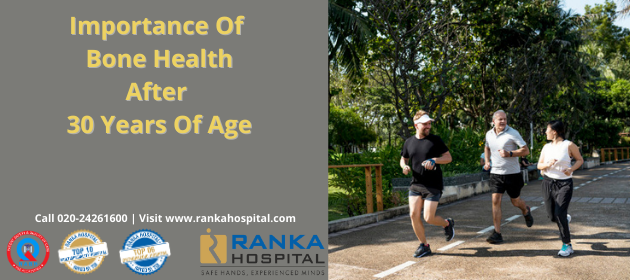Importance of Bone Health after 30 years of age
A few decades ago, usually, bone health used to begin deteriorating after the age of 40, and in some cases, beyond 50. Nevertheless, routine stress, inadequate nutrition, and the lack of exercise have brought bone-weakening to as early as 30 years of age.
One of the most significant reasons for reducing bone health is insufficient awareness about the bone heath situation across various ages. People stay unaware about bone changes across various ages and often, fail to prevent bone loss, or treat it, and thus begin suffering from osteoporosis.
In this view, this article highlights the various stages and marks the significance of bone health across multiple ages, including that from age 10-20, after 30, and beyond 50 years of age.It helps you know the impact of various natural and health-related conditions on your bones, and how to tackle them. Nevertheless, if you wish to know more and get a case-specific advice, you must connect with Ranka Hospital.
Peak Bone Mass
What is peak bone mass? Or, at which stage of an individual’s age is the peak bone mass established? The answer is between 10-20 years of age. Although yes, the condition varies from person to person and has different implications in males and females and the prevalent health conditions. Let us look at both of them.
Puberty constitutes a significant period for the development of the skeleton and the peak bone mass. In girls, peak bone mass is present by the age of 20, and in some cases, they continue to gain mass until the age of 30. Regular periods are significant for girls’ and women’s bone health, as they indicate the production of adequate amounts of estrogen, which further helps improve calcium absorption in kidneys and intestines.
On the other hand, males grow fastest at the age of 13 and 14 and usually stop growing by 17 to 18. Their peak bone mass occurs from about 9 to 12 months after the peak rate in height growth. In boys, obesity delays puberty and pose an adverse impact on peak bone mass. However, in girls, obesity accelerates puberty, and these two factors (obesity and puberty) have a different impact on the peak bone mass in them.
Bone Health Between Age 30 and 50
You start losing bones after you reach peak bone mass. Usually, the body continues with the remodeling process (bone replacement from old to new) until 40. But after 40, the process slows down, and the body replaces less bone. So, given the situation, people between ages 30 to 50 must exercise enough and intake 1000 mg of calcium and 1,000 IU of Vitamin D every day to minimize bone loss.
Bone Health After 50
After 50, men can continue with 1,000 mg of calcium every day. But, since women experience menopause during this period, they must increase their calcium intake to 1,200 mg. Menopause causes a considerable drop in the estrogen levels and leads to reduced bone health. It turns women more vulnerable to osteoporosis and fractures. Hence, regular doctor-recommended exercises and sufficient calcium intake are a must for better bone health.
Ranka Hospital – For Consultation and Treatment on Excellent Bone Health
Ranka Hospital is a leading hospital for osteoporosis treatment and consultation on maintaining excellent bone health. The hospital comprises several reputed and renowned orthopedic doctors that recommend the best bone treatments and give appropriate bone health advice depending on your health, age, and other specific factors. Book an appointment with Ranka Hospital to know more about how to keep your bones healthy.
Reference Link: https://orthoinfo.aaos.org/en/staying-healthy/healthy-bones-at-every-age/

